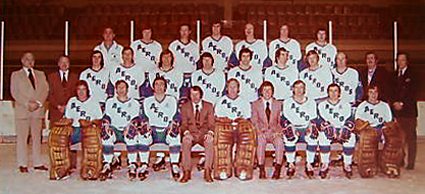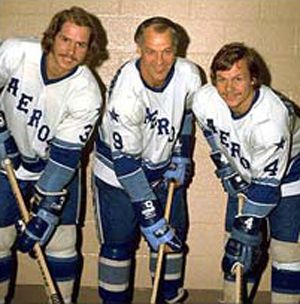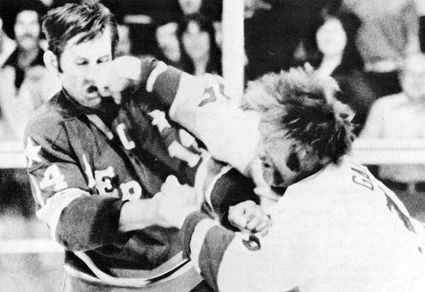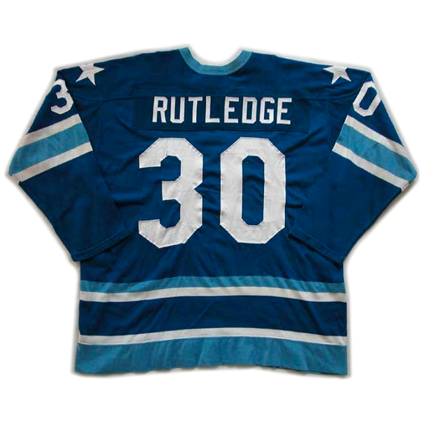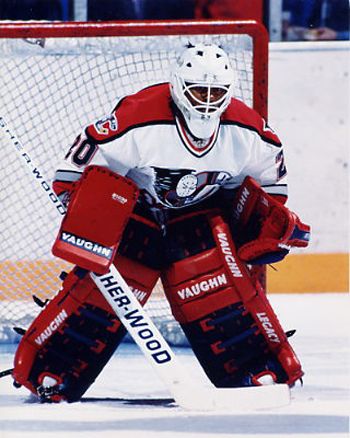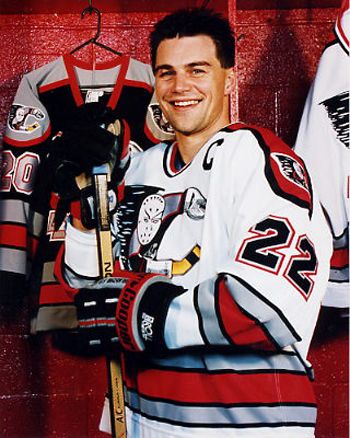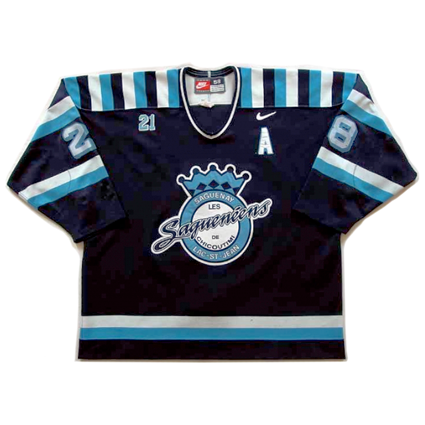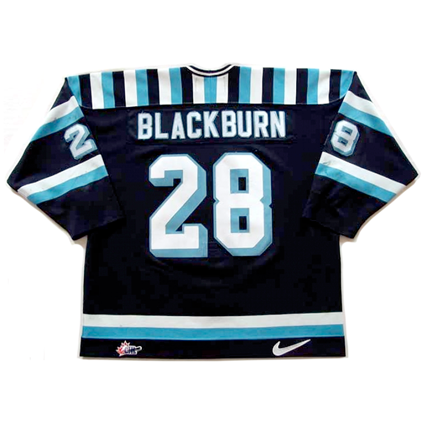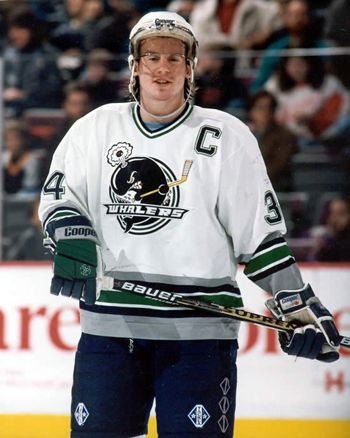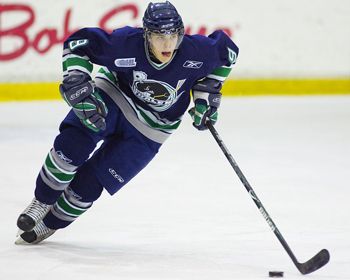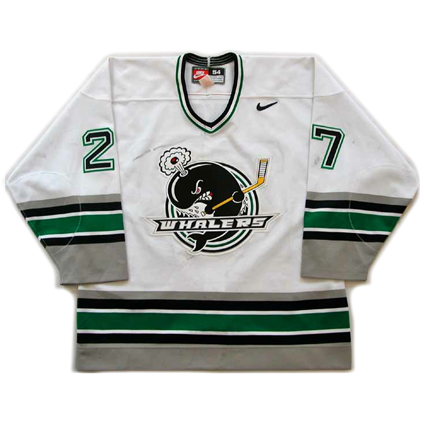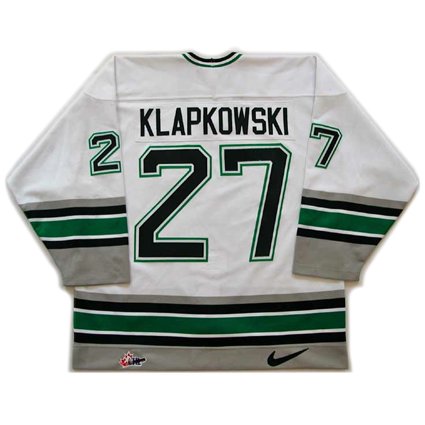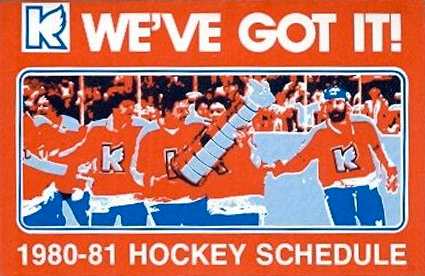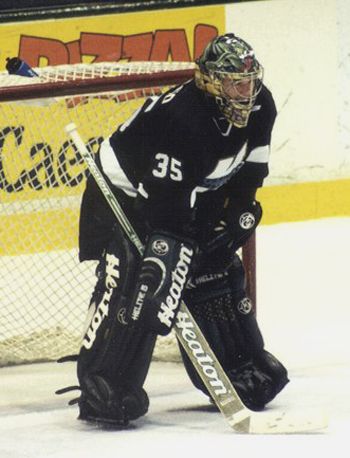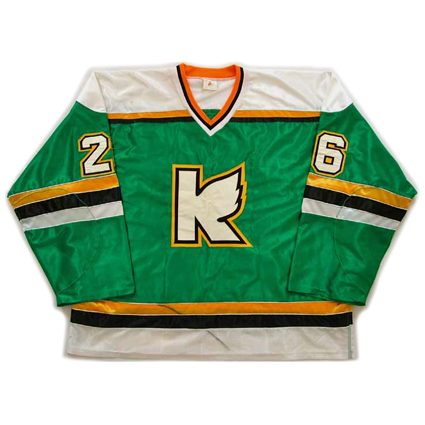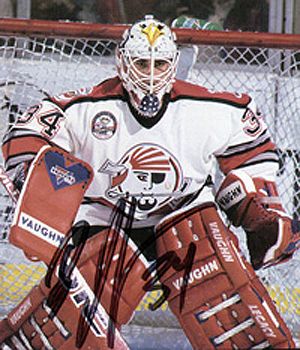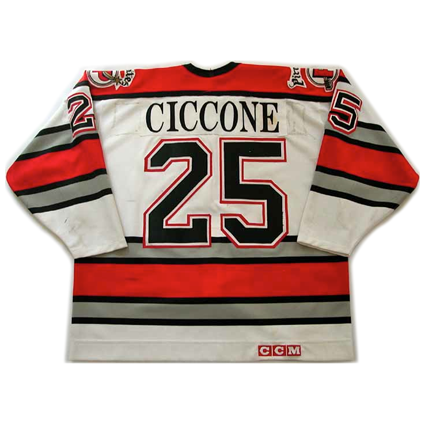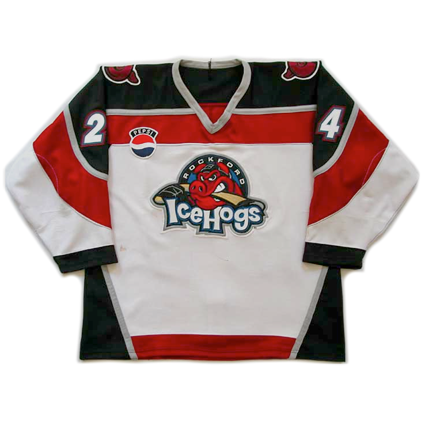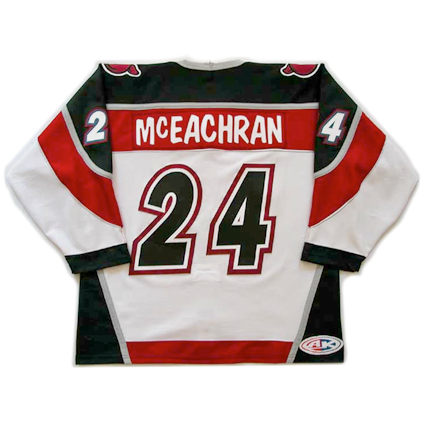Saturday, July 30, 2011
1974-75 Houston Aeros Wayne Rutledge Jersey
July by the Numbers makes it's way down to the Lone Star State for jersey #30.
The Houston Aeros of the WHA were originally slated to play in Dayton, Ohio, but never got off the ground, so owner Paul Deneau moved the club to Houston, Texas in time for the inaugural World Hockey Association season of 1972-73.
The Aeros, led in scoring by Gord Labossiere's 96 points in 78 games, had a cast of inexperienced journeymen players with an absolute minimum NHL experience, unlike other teams like the Quebec Nordiques, who could boast of long-time Montreal Canadien J. C. Tremblay or the Winnipeg Jets star Bobby Hull. Still, the Aeros finished second in the West Division and qualified for the playoffs and won a round before their season ended.
The 1972-73 Houston Aeros
Things changed, and in the biggest way possible, for the 1973-74 season. The Aeros had signed brothers Mark and Marty Howe to a pair of four-year, $400,000 contracts in early June of 1973 and two weeks later, they lured the boys' father and NHL legend, the 45-year-old Gordie Howe, who had already been inducted into the Hockey Hall of Fame following his retirement from the Detroit Red Wings after 25 seasons. It's safe to say that Howe's 1687 games of NHL experience was greater than the rest of the Aeros roster combined.
"My only regret is I'm sorry I'm not the Gordie Howe I was ten years ago to fulfill the goals the Aeros have in store for me. It's not too often an individual gets a second chance and that's what the Aeros have given me," Howe said. "A chance to play with my sons."
Gordie had surgery to improve his bad wrist and relished the opportunity to play with his sons. The elder Howe's well-earned reputation for toughness ensured that his son's would have plenty of time and space to learn their craft professionally, as any player who laid a big hit on Mark or Marty was sure to be paid back with interest by Gordie at the first available opportunity!
Gordie immediately led the team in scoring with an even 100 points, good for third place in the league, as the Aeros had the best record in the league by 11 points. Additionally, Gordie was also named the league's Most Valuable Player in 1974, a trophy that would be renamed in his honor in 1976, while he was still an active player! In the playoffs that season Houston swept the Jets in four and survived an all out war with the Minnesota Fighting Saints in six games to advance to the Avco Cup Finals.
Ted Taylor and Gord Gallant battle it out during the
memorable Aeros/Fighting Saints 1974 playoff series
Once in the finals, the Aeros swept the Chicago Cougars in four straight, giving the Aeros their first WHA title and Howe his first championship since 1955 with Detroit.
The original expectation in 1973 was that Gordie Howe, who also signed a four-year contract, would play one year and then move into the team's front office. That was not to be however, as Gordie returned for a second WHA season. While Larry Lund led the club with 108 points, Gordie duplicated his output from the season prior with 99 points while Mark Howe contributed 76 points from the blueline after 79 the year before.
The Aeros again won the West Division with the league's best record by 14 points and dispatched the Cleveland Crusaders in five and the San Diego Mariners in four prior to sweeping the Nordiques in the finals to defend their title and become the first repeat winner in WHA history.
Howe would once again lead the Aeros in scoring in 1975-76 with 102 points, 26 clear of his son Mark and Frank Hughes, but would only place 10th in the scoring race in the now wide-open WHA. Still, the Aeros were a solid all around team and once more led the league in regular season points with 106 points. The gap was narrowed to the rest of the league however, as Winnipeg tied them with 106, coming on one less win, and the Nordiques just two back at 104.
The battle tested Aeros knocked out the Mariners in six and the New England Whalers in seven, the first time anyone went the distance with Houston, to return to the finals for the third consecutive season in a row. The high powered Jets won a pair of one goal games in Houston and pulled away to win a pair of games back at home in Winnipeg to end the Aeros reign as league champions.
The following season saw Gordie Howe limited to 62 games and 68 points, yet once again the Aeros had the best regular season total for the fourth year in a row. After defeating the Oilers in round one, the Jets once again ended the Aeros championship aspirations in six games in the semifinals.
Prior to the 1977-78 season, with their four year contracts having now expired, all three Howes moved en masse to the Whalers and the high scoring Andre Lacroix now led the Aeros offensively. The Aeros finished third in the regular season standings and fell to the Nordiques in the first round four games to two.
Their loss in Game 6 at Quebec would be the final game in Aeros history, as the Aeros, who were included in merger talks with the NHL in 1977, were left out of the 1978 proposal and elected to fold on July 6, 1978.
While the Jets, Nordiques, Oilers and Whalers all survived to join the NHL for the 1979-80 season, the Aeros certainly can be viewed as one of the most successful clubs in the WHA, having finished with a winning record in each of their six seasons, four of which saw them with the best record in the league, and a pair of championships. The addition of the Howes gave the league a huge boost in credibility and exposure while allowing the legend of "Mr. Hockey" Gordie Howe to continue to grow.
Today's featured jersey is a 1974-75 Houston Aeros Wayne Rutledge jersey. This classic jersey combines a vintage font running diagonally across the front in the time-honored manner paired with a simple striping pattern topped off with a star on each shoulder proving less is more when it comes to an effective and timeless hockey jersey.
Today's video section has plenty of great footage and begins with Gordie discussing his coming out of retirement to join Houston with baseball great Tom Seaver.
Were very excited to share this rare footage of the Aeros winning the 1974 Avco Cup over the Chicago Cougars.
Here is some classic WHA game action between Houston and Winnipeg with Gordie scoring a goal and later getting ejected from the game!
Don't miss the exciting, miraculous conclusion of the same game between the Aeros and Jets on December 5, 1975.
Here is footage from the 1979 WHA All-Star Game, when Gordie famously played on a line with Wayne Gretzky.
Here is Gordie, along with Mark and Marty making an appearance on the game show "What's My Line?"
Finally, Gordie shows the kids how it's done.
Labels:
Houston Aeros,
Howe Gordie,
WHA
Friday, July 29, 2011
1995-96 Cincinnati Cyclones Jeff Greenlaw Jersey
July by the Numbers returns once again to Cincinnati for jersey #29.
When the owner of the ECHL's Cincinnati Cyclones was awarded a new International Hockey League franchise for the 1992-93 season, he retained the Cyclones identity for his new IHL franchise while moving his ECHL club to Birmingham, Alabama and renaming that club the Bulls.
The new IHL club missed the playoffs in year one, something that would never happen to them again.
Center Len Barrie arrived for the 1993-94 season and led the club with 116 points (second in the IHL) while Patrick Lebeau's 47 goals led the Cyclones in that category. The team made a great stride forward, leaping from 27 wins and 61 points to 49 wins and 107 points while Pokey Reddick went 31-12-6 in goal. Cincinnati then won their first ever playoff series by defeating the Kalamzoo Wings 4-1 before losing in the next round.
Pokey Reddick
They equalled their 49 wins in 1994-95, but raised their point total to 113, led by Dave Tomlinson's 110 points, which was also good for second in the IHL. The again won a playoff round by defeating cross-state Cleveland.
Ron Smith took over as head coach of the Cyclones for the 1995-96season and would be the only coach to ever command the club from that point forward. Tomlinson again led the club in scoring as they recorded their third consecutive 100 point season, this time reaching a franchise record 51 wins. The Cyclones then went on a nice playoff run, sweeping Atlanta in three games, eliminating Kalamazoo (now renamed Michigan) in a hard fought seven game series before falling in the semifinals to Orlando in seven games, concluding with a heartbreaking 1-0 loss at home.
While the Cyclones would not top 100 points again, they would remain consistently competitive, totaling between 92 and 97 points for the remainder of their five seasons in the IHL.
The 1997-98 season saw Todd Simon lead the club with 105 points as, he too, finished second in league scoring. It would not be until the 1999-00 season that they Cyclones would escape the second round of the playoffs when they were one of six teams to receive a bye in round one and then downed Orlando 4-2 in the second round before dropping a series to Grand Rapids.
Their final season of 2000-01 saw the Cyclones raise their point total to 97, their highest since 1996, but their season came to a quick end with a 4-1 defeat by Orlando.
Following the 2000-01 season, the IHL ceased operations and six of the 11 remaining clubs joined the American Hockey League, but the Cyclones were not one of them due to the presence of the Cincinnati Mighty Ducks, members of the AHL since 1997, just seven miles up the road.
Don Biggs ended up as the franchise's all-time leading scorer with 412 points, leading Gilbert Dionne's 336 and Paul Lawless' 304. The best known Cyclones to go on to NHL careers include Erik Cole, Bob Boughner, David Tanabe and Jan Bulis.
Don Biggs
The decline of the league brought an end to the nine year run of the Cyclones in the IHL, but not the Cyclones identity, which was sold to the owners of the ECHL's Miami Matadors, who moved their then dormant franchise to Cincinnati for the 2001-02 season, where they continue to play today.
Today's featured jersey is a 1995-96 Cincinnati Cyclones Jeff Greenlaw jersey. This shocking yellow jersey was the Cyclones alternate jersey, as their main dark jersey was black in color. For their first season of 1992-93, the Cyclones home jerseys were actually silver dazzle cloth before reverting to the traditional white in 1993-94. Their road jerseys also alternated between black and also red from season to season, with red also being used for alternate jerseys as well during their seemingly ever-changing looks.
In a moment straight out of the movie "Slap Shot", Cyclones coach Don Jackson scales the glass to get into a fight with the Atlanta Knights mascot!
Labels:
Cincinnati Cyclones,
IHL
Thursday, July 28, 2011
2001-02 Chicoutimi Saguenéens Alexandre Blackburn Jersey
Juillet par les Numéros retour à Québec pour de maillot n°28.
The Chicoutimi Saguenéens (pronounced Sheh-ku-ta-me Sa-gwa-nay-ens) were founded in 1973 and their name means "the people from Saguenay", which is a region in central Quebec.
The "Sags" have twice won the President's Cup as the QMJHL's playoff championship, first in 1991 and again in 1994. By winning the league's playoff title, they advanced to the Memorial Cup playoffs. They also participated in the Memorial Cup in 1997 as runners up in the QMJHL when the winners from Hull were hosts of the tournament, but the ultimate prize in Canadian junior hockey has so far eluded Chicoutimi.
Four times in their history the Saguenéens have won division titles, those coming in 1988, 1991, 1994 and 2002. Their record for most points in a season came in 2005-06 when they racked up 51 wins and 106 points, made possible by a strong team defense which allowed a team record low 185 goals against.
Many former Saguenéens have gone onto play in the NHL, with Marc Bergevin, Marc Bureau, Guy Carbonneau, Gord Donnelly, Gilles Hamel, Alan Haworth, Stephane Richer and Andre Roy have all played over 500 NHL games in addition to goaltenders Marc Denis and Felix Potvin to continue the tradition of goaltenders from Chicoutimi, started by legendary native Georges Vezina.
Numbers retired by Chicoutimi include Alain Cote's #14, Normand Leveille's #16, Sylvain Locas' #18, Marc Fortier's #20 and #21 for Carbonneau and #29 for Potvin.
Guy Carbonneau 1979-80
Today's featured jersey is a 2001-02 Chicoutimi Saguenéens Alexandre Blackburn jersey. We have always found jerseys done in sky blue and navy blue with white trim to be among some of the most attractive jerseys and this one is no exception. It's unique striped shoulder yoke gives the jersey an shot of adrenaline even when sitting still. It's also a hint of a classic turn of the century barberpole style without the dizzying full body effect. The choice of drop shadowed numbers also adds to the classic appeal of this very attractive jersey with is classy main crest topped with a regal crown.
The jersey also has a small #21 on the upper right chest that many will assume is a memorial to a fallen player, but it is in fact a tribute to the very much alive and well Guy Carbonneau, whose jersey #21 was retired by the club that season. In a departure from the expected, the #21 is not sewn on with twill, but embroidered directly into the team's jerseys.
Labels:
Chicoutimi Sagueneens,
QMJHL
Wednesday, July 27, 2011
2002-03 Plymouth Whalers Gary Klapkowski Jersey
July by the Numbers crosses to the other side of Michigan for jersey #27.
The Detroit Compuware Ambassadors were formed as an expansion team in the Ontario Hockey League for the 1990-91 season and would finish dead last with just 11 wins. After one more season they were renamed the Detroit Junior Red Wings and their fortunes improved from 27 wins to 37 to 42 and then 44 as the club won two division titles as well as the 1995 OHL playoffs to advance to their first Memorial Cup, making it all the way to the championship final and setting attendance records during the NHL lockout of 1995 in the process.
Club owner Peter Karmanos had been unsuccessful in his attempt to buy the NHL's Detroit Red Wings and instead purchased the Hartford Whalers in 1994, which led to the OHL club being renamed the Detroit Whalers. As a result of friction between the owner of the Detroit Red Wings and Karmanos following the failed deal to purchase the Detroit Red Wings, the Whalers moved out of Joe Louis Arena and up to the Palace of Auburn Hills for 1995-96. For the following season, Karmanos built his team a new home in Plymouth Township in time for the 1996-97 season.
For the 1997-98 season, the team was once again renamed, this time to the Plymouth Whalers. The Whalers then rose to new heights beginning with the 19998-99 season when they finished first overall in the OHL with 108 points and repeated the feat in 1999-00 with a league best 95 points. A second overall finish in 2000-01 gave the Whalers their third consecutive division title and they returned to the top of the heap once again in 2001-02 with 92 points. The Whalers kept their foot on the gas for their record tying fifth consecutive division title in 2002-03 with a 97 point season, their fifth over 90 points.
After winning another division title in a decidedly weak West Division in 2005-06 with just 75 points, the Whalers reloaded for the 2006-07 season. Led by Evan Brophey's 107 points and the goaltending duo of Michal Neuvirth (26 wins) and Jeremy Smith (23), the Whalers once again won the West Division with 103 points, one back of the league leading London Knights.
In the OHL playoffs, London and Plymouth advanced to the Western Conference Finals as expected and Plymouth dominated with a 4 games to 1 win before downing the Sudbury Wolves 4-2 to win the Robertson Cup and claim their place in the Memorial Cup for the second time in franchise history where they placed third.
Several Whalers have been drafted high in the NHL Entry Draft, with Bryan Berard taken first overall in 1995 when the club was known as the Jr. Red Wings leading the list.
Bryan Berard
David Legwand (1998) and Tyler Seguin (2010) were both selected second overall and Stephen Weiss at fourth overall in 2001 completing the list of top four picks from the Whalers. Seguin became the first Whaler to lead the OHL in scoring with his 106 points in 2009-10, which which was equalled by Taylor Hall of the rival Windsor Spitfires for the top spot.
Tyler Seguin
Other notable franchise alumni include Fred Brathwaite, Eric Cairns, Paul Mara, James Neal, Justin Williams and James Wisniewski, while Pat Peake is the only player in franchise history to have his number retired by the team.
Today's featured jersey is a 2002-03 Plymouth Whalers Gary Klapkowski jersey from the Whalers record season during which they won their fifth consecutive division title.
Being a part of the Hartford Whalers family, since they share the same owner, the Plymouth Whalers used the Hartford Whalers jersey template years after Hartford relocated to North Carolina to become the Hurricanes.
Today's video feature is highlights from the Plymouth Whalers taking on their rivals the Windsor Spitfires in a exciting OHL contest featuring lots of goals and fists. The two club's rinks are located just 30 miles apart and Windsor, Ontario is actually the only Canadian city located directly south of an American city.
Here is a profile on the Whalers Tyler Seguin, the second pick in the 2010 NHL Entry Draft.
Labels:
Plymouth Whalers
Tuesday, July 26, 2011
1989-90 Kalamazoo Wings Kevin Schamehorn Jersey
July by the Numbers travels to the Great Lakes area for jersey #26.
Founded for the International Hockey League's 1974-75 season, the Kalamazoo Wings rose from 10th out of 11 teams in their first win to second out of nine by year three thanks in no small part to having the top two and three of the top five leaders in penalty minutes.
After two semifinal losses in 1976-77 and 1977-78, the Wings had a solid season with a 40-28-12 record for the fourth best record in the IHL. The Wings then went on a roll, sweeping their first two playoff series to advance to the finals, where they alternated wins at home with the Grand Rapids Owls until taking Game 7 on the road 5-2 to claim their first Turner Cup championship. Tom Ross led the team in scoring with 116 points which was second overall in IHL scoring.
Carrying the confidence of their championship into the 1979-80 season, Kalamazoo finished first overall in the IHL that season with a 45-26-9 record, led in scoring this time by Tom Milani at 49 goals and 111 points with Ross second at 103. The Wings repeated as Turner Cup champions after defeating the Fort Wayne Komets in six games in the finals.
The Wings simply blitzed the league in 1980-81 with a 52-20-10 record for a franchise best 114 points, but their bid for a hat trick of titles fell short with a loss in the finals.
Brent Jarrett became the first Wing to win the scoring title when he totaled 124 points in 1981-82 and Dave Michayluk led "the I" in goals with 66 in 1984-85.
After having been affiliated with the Detroit Red Wings since the beginning, and wearing red, white and blue, a new affiliation with the Minnesota North Stars saw the club change to the North Stars colors of green, gold and black. Their arrangement with the North Stars brought little in the way of notoriety however, although they did manage to make the playoffs in all but one season, including two seasons with over 100 points.
They retained their affiliation with the Stars organization when Minnesota relocated to Dallas for the 1993-94 season and immediately Rob Brown simply ran away and hid in the scoring race, amassing 155 points, 39 points clear of his next closest pursuer - and exactly one game with the Stars that season.
After one more season as the Kalamazoo Wings, the club changed it's name to the Michigan K-Wings for the 1995-96 season hoping to draw a wider audience to the club. That season saw Jamie Langenbrunner spend the season with the K-Wings and finish second in team scoring before beginning his long NHL career.
The 1998-99 season saw the arrival of goaltender Marty Turco from the University of Michigan, who immediately became the team's starter and seeing action in 54 games his first season and 60 his second, which would prove to be the final season for the franchise, as Dallas ended their affiliation agreement and the franchise requested inactive status from the IHL, a league that would only last one additional season itself.
Marty Turco
There is a franchise which currently uses the name Kalamazoo Wings as members of the ECHL, which began life in Madison, Wisconsin in the United Hockey League before relocating to Kalamazoo and obtaining the rights to use the name and logo of the original Wings.
Today's featured jersey is a 1989-90 Kalamazoo Wings Kevin Schamehorn jersey from their days as a Minnesota North Stars affiliate when the club wore the green and gold of the North Stars.
Schamehorn had a long history with the Kalamazoo Wings, playing for the club during eight different seasons spread out over 14 years. After being drafted by the Red Wings in 1976, he played three seasons in Kalamazoo before moving on to other clubs and organizations. He returned to Kalamazoo in 1981 for four seasons prior to the change in affiliation to Minnesota. Again, Schamehorn moved on to other teams for four seasons, which included a year in France, before returning to Kalamazoo for his final season as a pro. During his absence, the Wings changed their affiliation from Detroit to Minnesota, which resulted in the change in team colors, allowing us to accurately date this green and gold Wings jersey to 1989-90.
This example illustrates the detective work involved in dating jerseys we enjoy so much when researching various jerseys, particularly minor league jerseys which lack comprehensive online visual databases that document each and every NHL jersey style and years worn.
Also of note, Kalamazoo's Wings Stadium is the 200th different place we have marked on our Third String Goalie map of jersey locations.
Labels:
IHL,
Kalamazoo Wings
Monday, July 25, 2011
1993-94 Portland Pirates Enrico Ciccone Jersey
July by the Numbers travels to the northeastern United States for jersey #25.
The Erie Golden Blades were created in 1978 as members of the short-lived Eastern Hockey League and won all three championships before the league folded and the team was admitted to the American Hockey League for the 1981-82 season. After one AHL season, the franchise merged with the Baltimore Skipjacks of the Atlantic Coast Hockey League and the new organization played as the Skipjacks in the AHL for 11 seasons before relocating to Portland, Maine for the 1993-94 season.
The relocated franchise was named the Portland Pirates and were affiliated with the Washington Capitals for 12 seasons. The club introduced themselves to the fans in Maine in fine style by winning the Calder Cup as league champions following a 43-27-10 regular season record. Jeff Nelson led the club with 107 points which was fourth overall in the league while the goaltending duo of Olaf Kolzig and Byron Dafoe led the team in goal.
Olaf Kolzig
Byron Dafoe
The Pirates second season saw then finish with 104 points as Nelson again led the team in scoring with three more points than future NHLer Andrew Brunette. Jim Carey took over the bulk of the goaltending duties in year two and posted a 30-14-11 record.
Andrew Brunette
Jim Carey
The club took a step back in the standings with a losing record (32-34-10-4), but weaved it's way through the playoffs, defeating Worcester, Springfield and Saint John to reach the finals for the second time in three seasons only to lose 2-1 in the decisive Game 7. Brunette led the club in scoring with 94 points in 69 games played.
For the remainder of their affiliation with the Capitals the team qualified for the playoffs six out of nine seasons, but won only one playoff series in 1998. They did post a 103 point season in 1999-00, but lost in the first round of the playoffs. Players to skate for the Pirates during this time period included Anson Carter, Richard Zednik, J. P. Dumont, Glen Metropolit, Rob Zettler, Brooks Laich and Tomas Fleischmann.
For the next three seasons the Pirates became the top affiliate of the Anaheim Ducks and the infusion of new players sent the Pirates rocketing up the standings with a 53-19-0-5 record for 114 points and the second best record in the AHL by a single point. After defeating Providence and Hartford, the Pirates lost to eventual champions Hershey in overtime of Game 7 in their semifinal matchup. Ryan Shannon led the club in points with 86 as part of a roster which included at times Dustin Penner, Corey Perry and Ryan Getzlaf.
Corey Perry
The Buffalo Sabres changed their affiliation to Portland for the 2008-09 season, an arrangement that brought Nathan Gerbe and Tyler Ennis to Portland as well as a pair of 100 point seasons.
For the upcoming 2011-12 season the Pirates will be aligned with the Phoenix Coyotes in the first year of a five year contract.
Today's featured jersey is a 1993-94 Portland Pirates Enrico Ciccone jersey from the Pirates successful first season in Maine during which they won their only AHL championship to date.
This jersey is in the classic hockey style of a colored shoulder yoke with matching arm and waist stripes. The thin, serifed font for the names on the back is out of the ordinary, but fits well with the pirate theme.
We must admit we are not fans of the numbers encroaching into the waist and sleeve stripes and would prefer the stripes to be a bit narrower and lower as to leave more room for the digits so they would remain only in the white areas of the jersey in the traditional manner.
The last thing to mention is the odd "Portland" bumper sticker on the left lower front of the jersey. We're not sure where it came from, why they felt it was necessary or how come it was offset to the left, but we're glad it was an idea that didn't catch on.
For today's video section, all we can say is: just what in the hell is this?
Wasn't it nice to see a 20 year old Suzy Kolber dressed for an apparent audition to join the cast of "Friends"? Plus, we always love seeing the original ESPN2 graphics with the black paintbrush look. Those don't look dated at all, do they?
Up next, some of the finest acting in a commercial featuring hockey players ever, ever, ever. Dude, Brian is a natural.
Finally, some actual game footage in this TV commercial for the club. Just how many mascots can one team have anyway? We saw a pirate, a parrot and we are pretty certain the bearded guy on the ATV was William Shakespeare.
Labels:
Portland Pirates
Sunday, July 24, 2011
1999-00 Rockford IceHogs Sean McEachran Jersey
July by the Numbers stops in Northern Illinois for jersey #24.
A member of the United Hockey League, the Rockford IceHogs came into being when the Thunder Bay Thunder Cats were sold and relocated to Rockford for the 1999-00 season after eight years and three championships (as wellas three different names!) in Canada.
The name "IceHogs" was chosen after a "name the team" contest. Jason Firth led the team in scoring with 110 points and the club was a first round exit from the playoffs in year one. The IceHogs failed to make the playoffs in both 2000-01 and 2001-02 but a winning record in 2002-03 returned them to the playoffs but another first round exit awaited them.
A large step back in 2003-04 saw them drop 16 points in the standings and once again fail to qualify for the postseason. The IceHogs began to climb up the standings in 2004-05 when they were led in scoring by Jean-Francois Dufour's 79 points in 77 games. Rockford finished in second place in the Western Division with a 46-25-9 record for 101 points and followed that success by winning their first ever playoff series in Illinois with a 4 games to 2 win over the Kalamazoo Wings before falling to the Fort Wayne Komets in overtime of Game 7 in Round 2.
2005-06 saw the IceHogs improve to a 48-19-9 mark for 105 points and the Western Division title. Rockford bounced For Wayne in Round 1 in five games but were swept by Kalamazoo in the second round.
The IceHogs had another strong regular season in 2006-07, again reaching 48 wins on the way to 103 points and second place in the west. Rockford had an easy time ousting the Quad City Mallards in five games prior to doing the same to Fort Wayne in the second to advance to the finals.
The IceHogs opponents in the finals Kalamazoo required a full seven games in the previous round to advance, giving the IceHogs and additional four days rest, which may have paid off when Game 1 in Rockford required overtime before the IceHogs won 3-2. They cruised to an easy 6-1 win, also at home, in Game 2.
The Wings won games 3 and 4 on home ice 3-0 and 6-5 to send the series back to Rockford for Game 5, where Rockford again won by a score of 6-1 to reach the brink of a championship. Kalamazoo held serve at home in Game 6 with a 6-2 victory to set up a decisive Game 7 back in Rockford.
Rockford made it a clean sweep for the home teams when they captured the Colonial Cup with a 3-1 win in Game 7, which would prove to be the final game in franchise history.
Off the ice, the team's arena authority, who controls the Rockford MetroCentre, purchased both the dormant Cincinnati Mighty Ducks franchise of the American Hockey League, as well as the rights to the UHL's IceHogs identity as part of a 23 million dollar plan to extensively renovate the arena, brining to an end the seven year history of the UHL IceHogs.
The new version of the IceHogs would sign a 10 year agreement with the Chicago Blackhawks of the NHL and compete in the AHL as Chicago's top minor league affiliate, two levels higher up the minor league ladder than the UHL was considered, and take to the ice with the same logo and colors as their predecessors.
Today's featured jersey is a 1999-00 Rockford IceHogs Sean McEachran jersey from the IceHogs debut season in the UHL. Free of the pressures to create a jersey which must generate millions of dollars of income in merchandise sales at the NHL level, minor league jersey designers have the opportunity to take more risks when outfitting their teams.
While some may take the approach of simply putting their logo on the same template as their parent club, especially higher up in the minors when teams have an affiliation with specific NHL clubs, the IceHogs had the freedom to create an attractive new design with bold arm striping, bold numbers and an unusual choice of font for the names on the back, one seldom seen on a hockey jersey.
While the IceHogs logo is very cartoonish, as can often be the case in the low minors, the rest of the jersey is an effective and attractive package overall, and benefits from the solid black and red color combination, avoiding trendy colors which can quickly look dated as tastes change.
Today's video selection is the final two minutes of the UHL's IceHogs as they win the Colonial Cup on home ice.
Labels:
Rockford IceHogs
Subscribe to:
Comments (Atom)

